5 Franc (sold for $218.0)
1869, Switzerland, Zug (Canton). Large Silver Shooting Thaler (5 Fr.) Coin. R!
Mint Year: 1869 Mintage: 6.000 pcs. Designer: Antoine Bovy Denomination: 5 Francs ("Shooting Thaler") References: Davenport 384, HMZ 2-1343h, KM-XS10. R! Condition: Lightly wiped/cleaned a while a go, a few scratches in fields, otherwise XF! Material: Silver (.835) Weight: 24.99gm Diameter: 37mm
Obverse: Standing soldier (Hans Landwing) holding halberd and rescued flag (a historical scene of the Battle at Arbedo). Legend: HANS LANDWING RETTET DAS PANNER BEI ARBEDO – 1422 Translated: "Hans Landwing saves the banner at Arbedo – 1422" Legend: A. BOVY (1422) SC .t Reverse: Shooter´s plummed hat above two shield of Switzerland & Zug. Crossed rifles and wreath in background. Legend: EIDGENÖSSISCHES SCHÜTZENFEST 1869 IN ZUG – 5 Fr. Translated: "Federal shooting festival in Zug – 1869"
The Battle of Arbedo was fought on June 30, 1422 between the Duchy of Milan and the Swiss Confederation. In 1419, Uri and Unterwalden bought the Bellinzona stronghold from the Sacco barons, but were unable to defend it adequately. When, in 1422, they rejected the Milanese proposal to buy back the fortified town, their troops stationed in Bellinzona were put to rout by the Visconti army under the command of Francesco Bussone, called Il Carmagnola. An attempt to reconquer the fortified area with the support of other confederates led to the battle at Arbedo, a village 3 km north of Bellinzona. The Count of Carmagnola led the forces of the Duchy of Milan against the Swiss and was victorious. The Swiss were mainly equipped with halberds and had an initial success against the Lombard cavalry charge. Then Carmagnola brought his crossbowmen forward, while dismounting his cavalry. The dismounted men-at-arms used pikes which outreached the halberds. The Swiss were further under pressure by the crossbow fire on the flanks. The Milanese force began to push back the Swiss, who were only saved from total disaster by the appearance of a band of foragers, whom the Milanese were convinced represented a major new force. When the Milanese force pulled back to reform, the Swiss fled the battlefield, having taken heavy casualties. The victory secured Bellinzona and the Leventina to the Duchy. In addition the Duchy gained the Val d'Ossola, thus the Swiss losing all the territorial gains they had made. The defeat discouraged the Swiss expansionist intentions towards Lake Maggiore for a long time. It was the defeat at Arbedo that made the Swiss increase the number of pikemen.
The town Zug was first mentioned in 1240, was called an "oppidum" in 1242 and a "castrum" in 1255. In 1273, it was bought by Rudolph of Habsburg from Anna, the heiress of Kyburg and wife of Eberhard, head of the cadet line of Habsburg. Part of its territory, the valley of Aegeri, was pledged by Rudolph in 1278 as security for a portion of the marriage gift he promised to Joanna, daughter of Edward I of England. She was betrothed to his son Hartmann, but his death in 1281 prevented the marriage from taking place. The town of Zug was governed by a bailiff, appointed by the Habsburgs, and a council, and was much favored by that family. Several country districts (e.g., Baar, Menzingen, and Aegeri) each had its own "Landsgemeinde" but were governed by one bailiff, also appointed by the Habsburgs; these were known as the "Aeusser Amt," and were always favorably disposed to the Swiss Confederation.
On June 27, 1352, both the town of Zug and the Aeusser Amt entered the Confederation, the latter being received on exactly the same terms as the town, and not, as was usual in the case of country districts, as a subject land; but in September 1352, Zug had to acknowledge its own lords again, and in 1355 was obliged to break off its connection with the league. About 1364, the town and the Aeusser Amt were recovered for the league by the men of Schwyz, and from this time Zug took part as a full member in all the acts of the league. In 1379, the Holy Roman Emperor Wenceslaus exempted Zug from all external jurisdictions, and in 1389 the Habsburgs renounced their claims, reserving only an annual payment of 20 silver marks, which came to an end in 1415. In 1400 Wenceslaus gave all criminal jurisdiction to the town only. The Aeusser Amt, in 1404, then claimed that the banner and seal of Zug should be kept in one of the country districts and were supported in this claim by Schwyz. The matter was finally settled in 1412 by arbitration, and the banner was to be kept in the town. Finally in 1415, the right of electing their landammann was given to Zug by the Confederation, and a share in the criminal jurisdiction was granted to the Aeusser Amt by German king Sigismund.
In 1385, Zug joined the league of the Swabian cities against Leopold III of Austria and shared in the victory of Sempach, as well as in the various Argovian (1415) and Thurgovian (1460) conquests of the Confederates, and later in those of Italy (1512), having already taken part in the occupation of the Val d'Ossola. Between 1379 (Walchwil) and 1477 (Cham), Zug had acquired various districts in its own neighborhood, principally to the north and the west, which were ruled till 1798 by the town alone as subject lands. At the time of the Reformation, Zug clung to the old faith and was a member of the Christliche Vereinigung of 1529. In 1586, it became a member of the Golden League.
In 2001, 11 members of the local (cantonal) parliament and three members of the (cantonal) government were shot and killed in Zug by the assassin Friedrich Leibacher.
Only 1$ shipping for each additional item purchased!

|
Posted by:
anonymous 2017-06-02 |
|
||
|
||
|
||
|
||
1 Ruble Russian Empire (1720-1917) Silver Alexander I of Rus ...
group has 133 coins / 118 prices
⇑




 English
English






-300-150-0e4KbzbiWwIAAAFL1cH6Aggm.jpg)






